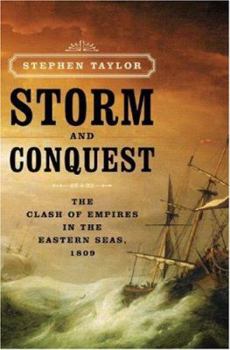Storm and Conquest: The Clash of Empires in the Eastern Seas, 1809
Select Format
Select Condition 
Book Overview
The Indian Ocean was the final battleground for Nelson's navy and France. At stake was Britain's commercial lifeline to India--and its strategic capacity to wage war in Europe. In one fatal season,... This description may be from another edition of this product.
Format:Hardcover
Language:English
ISBN:0393060470
ISBN13:9780393060478
Release Date:January 2008
Publisher:W. W. Norton & Company
Length:400 Pages
Weight:0.05 lbs.
Dimensions:1.3" x 6.5" x 9.5"
Customer Reviews
2 ratings
good naval history
Published by Thriftbooks.com User , 16 years ago
Great wars tend to be defined by certain battles and theaters. We think of the US Civil War as a battle east of the Mississippi, with Gettysburg, Shiloh, etc, as characterizing the war. WW I was the trench warfare on the Western Front. The Napoleonic Wars were Waterloo, Trafalgar, and the retreat from Moscow. But in each of these, men died in bloody combat far from the major theaters--died not in insignificant fighting for little purpose, but often for vital operations. Glorietta, New Mexico, was the scene of an important fight involving a couple of thousand men rather than the tens of thousands at Gettysburg, for instance. But it stopped the Confederate forces from capturing the Colorado gold fields. East Africa and Arabia in WW I were important campaigns: the Turkish forces could have captured the Suez Canal, and British India could have been thrown into turmoil. Storm and Conquest describes the little-known campaign in the Indian Ocean in 1808-10: during the Napoleonic Wars. England needed gunpowder, and needed the high-quality saltpeter from India to make it. The French forces threatened a major disruption in the vital trade links between India and England. Interest in this campaign has, of course, been aroused by O'Brian's novel, but Storm and Conquest helps to fill what is rather a void in historical works. You'll see quite a variety of personalities--the Pellews, Barlows, Corbet at sea and in India, Flinders as a prisoner on Mauritius, and others. The emphasis tends to be on the British side: there are descriptions of the French, but I'd guess that this would amount to less than 20% of the book. Some of the most interesting characters are French, and unfortunately they seem to get short shrift compared to the English. The book is also rather limited in scope: 1808-10 was certainly not the first naval campaign in these waters. Brief mention is given to the battles between Suffren and Hughes in 1782. You'd have thought that history would have taught the British a lesson about the vital trade line to India, but apparently it didn't. Storm and Conquest relates how the superior French frigates wreaked havoc on the weaker English vessels. So I would have liked to have seen more context here--much more on the larger picture and the earlier history--the French and British strategic views, and also more on the French side of things. Nonetheless, this is a welcome addition, especially for those of us who also appreciate the sacrifices made in distant and forgotten theaters.
A Little-known Napoleonic Naval Campaign
Published by Thriftbooks.com User , 16 years ago
A natural audience for Stephen Taylor's "Storm and Conquest: The Clash of Empires in the Eastern Seas, 1809" would be fans of Patrick O'Brian's fine naval historical novel, "The Mauritius Campaign." Taylor history relates the story (and provides extensive background) for the actual historical events described fictionally in O'Brian's novel, leading up to the Royal Navy's conquest of French-held Mauritius (and nearby islands) in the Indian Ocean during the Napoleonic Wars. Taylor's focus is somewhat diffuse, the actual Mauritius Campaign only forming part of the book, with much attention paid to politics and personalities in British India beforehand. And it is not only a story of war, but also struggle of the fleets of British merchant vessels against the fierce storms of the Indian Ocean, even more deadly than enemy vessels. One small quibble with the book's subtitle. Although "1809" is emphasized in that subtitle, the book actually also covers many events in 1808 and events come to a climax in 1810. Taylor's book provides a look at several historical figures featured in Patrick O'Brian's novel, in one major case (Captain Robert Corbert) developing a quite different picture from what is found in the pages of the novel.





